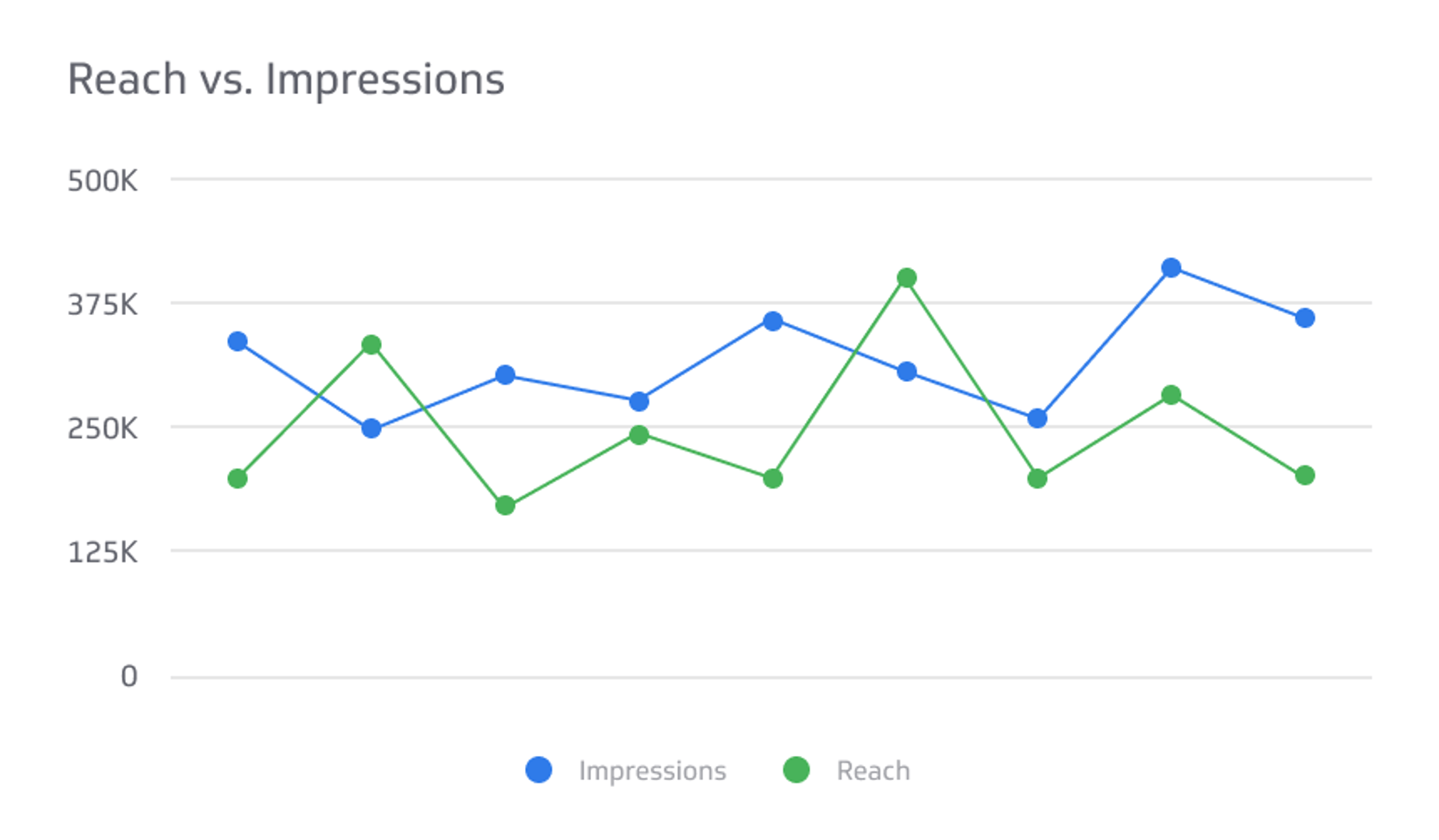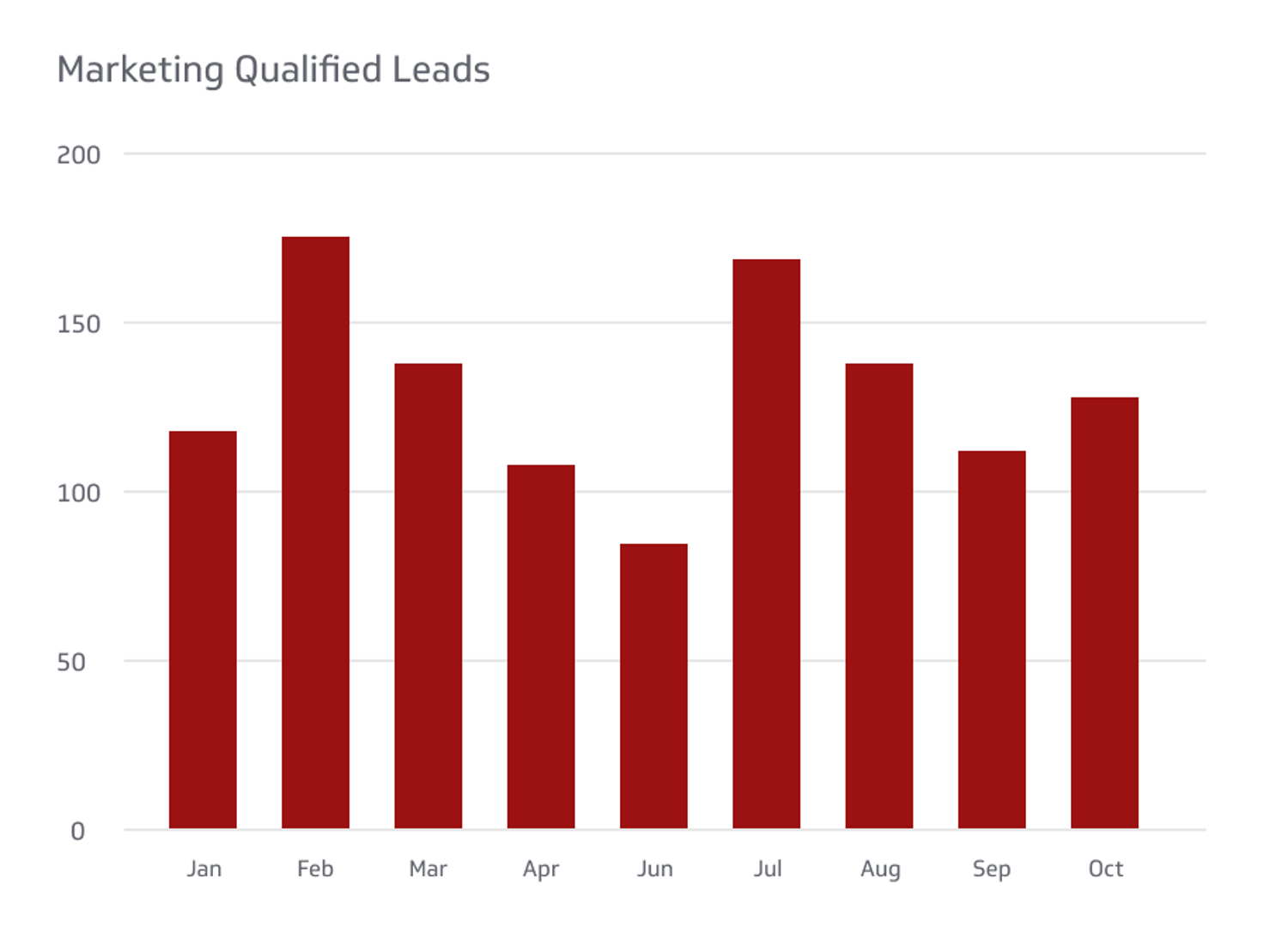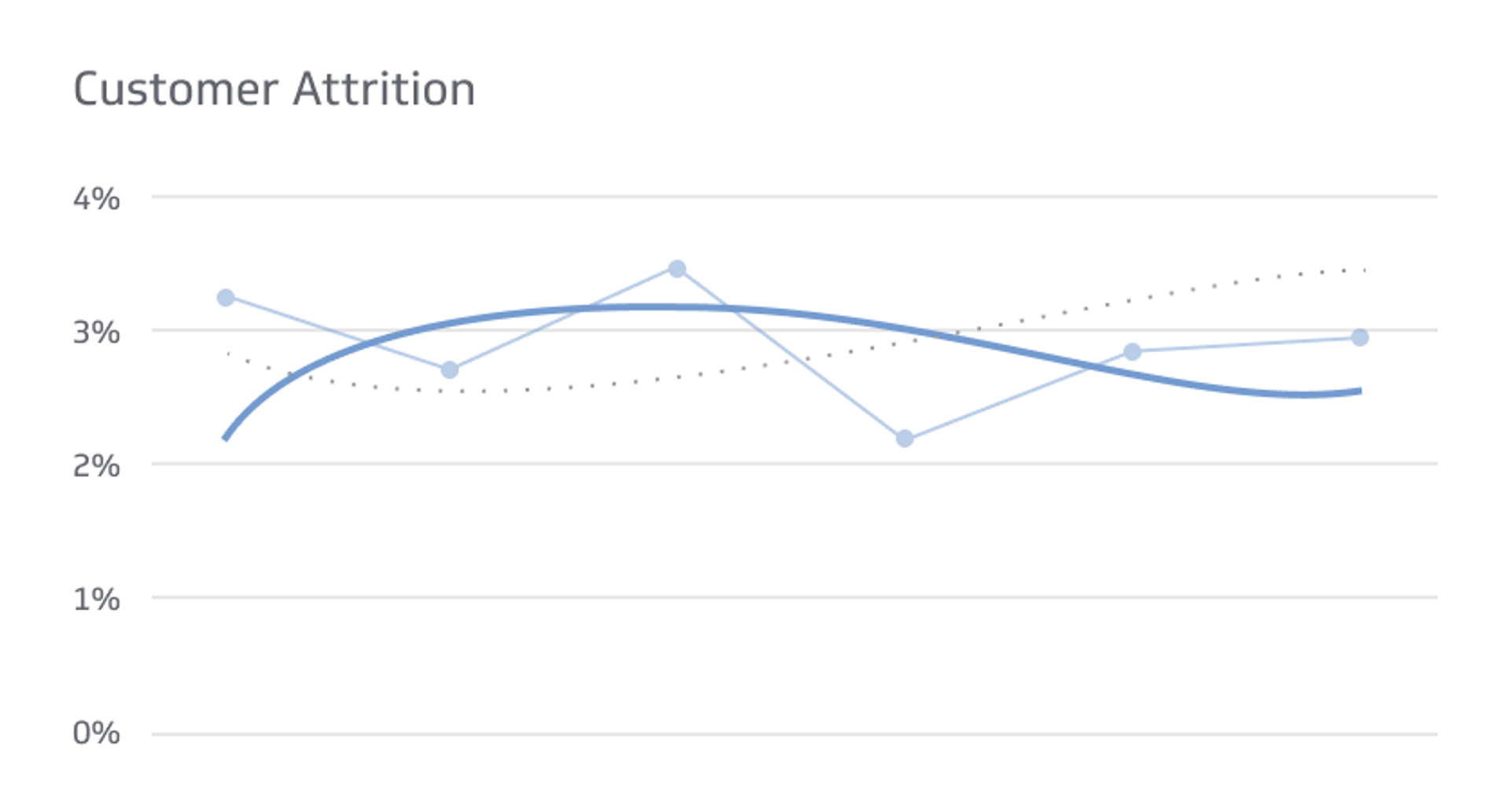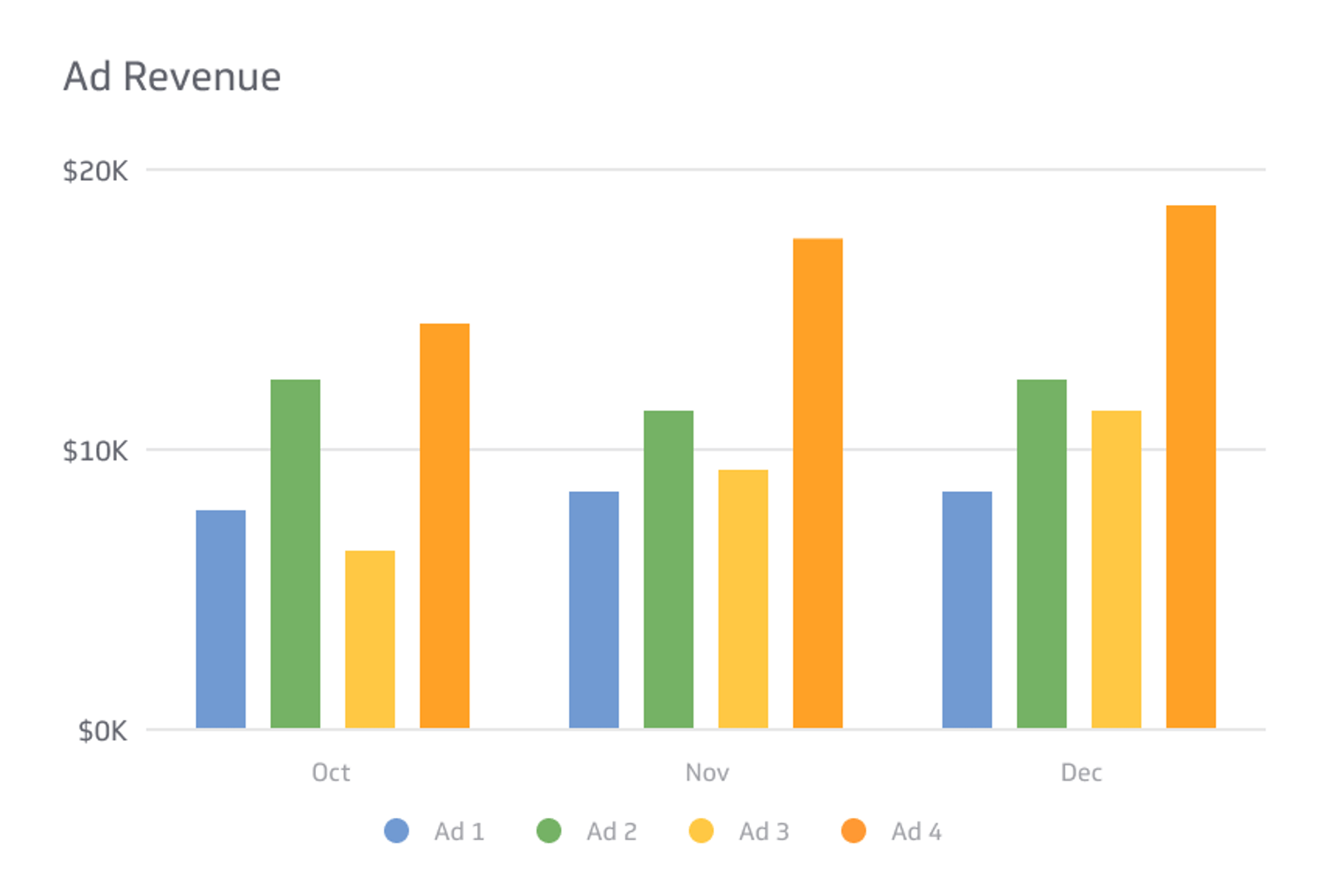Reach vs. Impressions
Both metrics, reach and impressions, play a crucial role in optimizing marketing strategies effectively. However, they do it in different ways.
Track all your Digital Marketing KPIs in one place
Sign up for free and start making decisions for your business with confidence.

To succeed in the rapidly changing landscape of social media marketing, it is vital to comprehend the distinction between reach and impressions. These two metrics are essential in evaluating the effectiveness of your campaigns and making data-driven decisions to improve performance.
Are you struggling with your marketing efforts? You’re not alone. The social media world is constantly evolving, and you do not want to be left behind. Luckily we have your back!
In this blog post, we look at how different platforms define reach and impressions and their importance in developing a successful marketing strategy.
We will also explore various tools for monitoring these key social media metrics across Instagram, Facebook, and Twitter.
Moreover, you will learn how to adapt your marketing strategies based on these metrics by adjusting target audiences and repurposing material when necessary.
Finally, we will discuss staying ahead in the ever-changing social media landscape by adapting strategies to algorithmic changes and exploring additional platforms such as Snapchat and Google Analytics Ads.
By understanding reach vs. impressions more thoroughly, you can strike an effective balance between them to achieve optimal results for your campaigns. Without any more ado, let us dive right in!
Defining Reach and Impressions
In social media marketing, reach refers to how many unique accounts or individuals have seen your content at least once. This metric helps marketers understand how many people they are reaching with their message.
On the other hand, impressions refer to the total number of times a screen has displayed your content, regardless of whether users clicked on it.
Both metrics play a crucial role in optimizing marketing strategies effectively. However, they do it in different ways.
The Importance of Understanding Reach and Impressions
An effective social media marketing strategy requires a clear understanding of reach and impressions as they provide valuable insights into audience targeting and engagement levels.
Analyzing these digital marketing metrics can enable businesses to identify where their campaigns need improvement and what content resonates most with their target market.
The most important metrics are total impressions, social media reach, and user sees. So, what is the difference between them?
- Total impressions help measure overall visibility by showing how often users see your posts.
- Social media reach indicates the size of potential audiences exposed to your brand's messaging.
- User sees provides information about individual user behavior for further segmentation and personalization efforts.
Different Platforms Define These Metrics Differently
To make informed decisions based on reach vs. impressions data, you must know how different platforms define these metrics:
- Facebook Reach: This platform measures both organic (unpaid) and paid reach separately. Facebook counts every time an ad appears on the screen when calculating reach.
- Instagram Reach: Is defined as unique views and shows how many people have seen your content at least once. It includes liking, commenting, and sharing by users.
- Twitter Reach: While Twitter does not provide specific data for reach like Facebook or Instagram, it focuses more on engagement. Metrics for engagement include retweets and likes to measure the success of campaigns.
In conclusion, impressions and reach are important metrics in social media marketing. Understanding the difference between the two and how you define them on different platforms can help you optimize your marketing strategies and reach your target audience effectively.
Reach and impressions are a crucial part of successful marketing, so it is important to understand how each platform defines these metrics. Metrics on social media can be quite disparate, so let's investigate Instagram, Facebook, and Twitter for more info.
Metrics Across Social Media Platforms
Social media platforms calculate reach and impressions differently, impacting the way marketers interpret their campaign performance.
Understanding how each platform defines these metrics is crucial for developing a successful marketing strategy.
Instagram's Approach to Measuring Reach and Impressions
Instagram Reach refers to how many unique users have seen your content at least once, while Instagram Impressions represent the total number of times your content has been displayed on the screen.
Instagram provides insights into both organic and paid reach, allowing you to evaluate how well your audience targeting efforts are working.
- Paid Reach: Refers to how many unique accounts saw an ad as a result of paid promotion.
- Total Impressions: Includes all viewed impressions, whether they come from organic or paid sources.
Facebook's Method for Calculating These Metrics
In contrast with Instagram, Facebook measures its reach metric by counting every time an ad appears on the screen, regardless of whether someone clicks on it.
Multiple views by one user will count as multiple impressions but only one instance of reach. Similar to Instagram, Facebook also differentiates between organic and paid reach:
- Paid Reach: How many people saw your post due to ads or sponsored posts (also known as "boosted" posts).
- Organic Reach: The number of people who saw your post without any paid promotion.
Twitter's Focus on Engagement Over Specific Numbers
Twitter Impressions refer to the total number of times a tweet has been displayed, regardless of whether someone clicked on it. Rather than providing exact reach figures, Twitter emphasizes engagement metrics such as retweets and likes to gauge the success of content.
Emphasizing engagement underscores the significance of producing content that appeals to your intended demographic and encourages participation.
Understanding how each social media platform calculates reach and impressions is essential for developing an effective marketing strategy tailored to each platform's unique characteristics.
By closely monitoring these metrics across different platforms, marketers can make informed decisions about their campaigns and adjust them accordingly to achieve desired results.
Metrics across social media platforms are a great way to measure the success of your campaigns and can be tailored to suit different needs. To further optimize performance, tools for monitoring reach vs. impressions should also be considered.
Tools for Monitoring Reach vs. Impressions
To analyze both metrics efficiently, marketers can use various tools like Iconosquare, Sotrender, Sprout Social, or third-party apps that integrate multiple platforms for comprehensive evaluation of campaign strategies.
These tools cover Instagram and Facebook data while providing insights into how paid campaigns are performing.
Iconosquare - Analytics Tool Focused Primarily on Instagram Performance Analysis
Iconosquare is a powerful analytics tool designed specifically to help businesses monitor their Instagram reach and impressions. With its user-friendly interface, Iconosquare provides valuable insights such as the best times to post content, top-performing posts, audience demographics, and more.
By using the data from Iconosquare, you can tailor your marketing tactics to maximize engagement with your desired demographic.
Sprout Social - Comprehensive Management Solution Covering Monitoring and Reporting
An all-in-one social media management platform Sprout Social offers robust features that allow users to track reach and impressions across multiple channels, including Facebook and Twitter.
The platform's detailed reports provide an overview of key metrics such as total impressions, paid reach, and viewed impressions, along with other important social media metrics like engagement rates (including liking) and audience targeting.
This data helps brands make informed decisions about their marketing strategy by identifying trends in user behavior.
Bonus Tool: Google Analytics
For those looking for additional options when it comes to tracking reach vs. impressions on different platforms, consider using a tool like Google Analytics.
Google Analytics, though not tailored for social media marketing, can give significant data about website activity and user behavior that could help form your general promotional plan.
By leveraging Google Analytics, you can gain valuable insights into reach and impressions to inform your decisions regarding audience targeting, ad spending, and more.
By gauging the number of viewers for your content (reach) and how many times it appears on a screen (impressions), you'll be able to make decisions based on data about targeting and expenditures, among others.
Tools for monitoring reach and impressions are essential to ensure that marketing strategies remain effective and up-to-date. By adjusting target audiences and repurposing material, marketers can further optimize their campaigns to achieve the desired results.
Adapting Marketing Strategies Based On Metrics
Understanding the difference between reach vs. impressions is essential when developing effective online marketing strategies.
Each metric delivers varying results based on which one is chosen to be tracked closely by businesses seeking desired outcomes such as increased brand awareness or improved ad performance.
By analyzing these metrics, marketers can make informed decisions about their marketing strategy, audience targeting, and content creation.
Adjusting Target Audiences and Repurposing Material as Necessary To Achieve Desired Results
There are many ways you can adjust target audiences and re-use content to get to where you want to go. Below are a few ways you can adjust your methods without changing your goals.
- Audience Targeting: If your reach shows that you are not reaching your target audience effectively, consider refining your audience targeting parameters.
For example, if you notice a low Facebook reach for a specific age group, adjust the settings in your ad campaign to better target that demographic.
- Content Creation: Analyzing both total impressions and the unique user sees can help determine whether the content being shared resonates with viewers or needs improvement.
High-quality content increases engagement rates (including liking), leading to higher overall media impressions.
- Paid Reach: When organic social media reach isn't delivering desired results, paid reach refers may be necessary for boosting visibility among potential customers.
Use platforms like Instagram Ads or Facebook's Power Editor tool to create targeted campaigns aimed at increasing exposure within specific demographics.
- Multichannel Approach: Don't limit yourself to just one platform. Leverage multiple channels like Twitter reach alongside Instagram and Facebook impressions for maximum impact on audiences across different networks.
A multichannel approach will help in tracking reach and impressions more effectively, providing a comprehensive view of your marketing strategy's success.
Closely tracking the metrics and making adjustments to your approach as needed can give you optimal outcomes.
Stay informed about the latest trends and algorithm changes on each platform by following industry news sources like Social Media Examiner or attending relevant conferences to ensure that you're always ahead of the curve when it comes to social media marketing strategy.
By adapting marketing strategies based on metrics, businesses can stay ahead of the ever-changing social media landscape and maximize their reach to targeted audiences.
Leveraging platforms like Snapchat and Google Analytics Ads is a great way to boost marketing efforts while also ensuring that content remains relevant in an ever-evolving digital environment.
Staying Ahead in the Ever-Changing Social Media Landscape
Keeping up with changes, trends, and algorithms within the social media industry is vital for maximizing potential growth opportunities.
Brands must be aware of platform-specific updates such as Instagram's decision to stop showing likes on posts or Twitter’s only providing impression data without any reach information.
In this section, we will discuss how to adapt strategies based on algorithmic changes and explore additional platforms like Snapchat and Google Analytics Ads for boosting marketing efforts.
Adapting Strategies Based on Algorithmic Changes
Staying on top of the dynamic world of social media necessitates keeping an eye on and changing your marketing tactics following fresh features and algorithm updates.
For example, when Instagram started hiding likes, marketers had to shift their focus from vanity metrics towards more meaningful engagement indicators such as comments and shares.
So, what are some things you can do to stay ahead of algorithmic changes? Let’s look at them below.
- Stay informed: Regularly follow industry news sources like Social Media Examiner and Marketing Land, or subscribe to newsletters from your preferred platforms.
- Analyze performance: Keep a close eye on your analytics data using tools like Iconosquare or Sprout Social (mentioned earlier) so you can identify trends that may indicate an algorithm change affecting your content's visibility.
- Pivot quickly: Be prepared to make swift adjustments if necessary - whether it means tweaking post formats or revising audience targeting strategies - so you can maintain optimal results despite evolving algorithms.
Exploring Additional Platforms for Boosting Marketing Efforts
In addition to adapting your strategy to existing platforms, consider expanding your marketing efforts to other social media channels or advertising options.
Snapchat and Google Analytics Ads are two examples of alternative avenues that can help you reach a broader audience and diversify your online presence.
Let’s take a look at how they can help you succeed.
- Snapchat: With over 280 million daily active users, Snapchat offers unique opportunities for businesses targeting younger demographics. Use features like sponsored lenses, filters, or Snap Ads to engage with potential customers in creative ways.
- Google Analytics Ads: Incorporate display ads into your marketing strategy by using the powerful targeting capabilities offered by Google Display Network (GDN). This platform allows you to reach specific audiences based on their interests, browsing behavior, and more - helping you drive conversions efficiently.
Finding success in the ever-changing world of social media requires staying informed about industry trends while continually adjusting strategies as needed.
By doing so, brands can maintain a competitive edge and achieve optimal results from their marketing efforts across various platforms.
Staying ahead in the ever-changing social media landscape requires a keen eye for detail and an understanding of how to adapt strategies based on algorithmic changes.
To ensure optimal results, you should explore additional platforms while balancing reach vs. impressions metrics that best align with your campaign objectives.
Balancing Reach vs. Impressions for Optimal Results
The debate over the importance of reach versus impressions continues among marketers. Both metrics have their place in measuring success depending on specific goals set by a business or brand.
By using a combination of these metrics and adjusting strategies accordingly, brands can achieve optimal outcomes while increasing overall performance.
Determining Which Metric Aligns Best with Your Campaign Objectives
When planning your social media marketing strategy, it's crucial to identify which metric - reach or impressions - is more relevant to your campaign objectives.
For instance, if you're aiming to increase brand awareness, focusing on reach might be more beneficial as it shows how many unique users are exposed to your content.
Impressions can be a better gauge of ad performance and engagement when looking to improve those metrics because they reveal how often users come across the ads and interact with them.
Striking an Effective Balance Between Reach and Impressions
Finding the right balance between reach and impressions depends on various factors such as audience targeting, platform algorithms, content quality, and posting frequency.
Here are some tips that can help:
- Analyze data from multiple platforms: Use tools like Iconosquare, Sprout Social, or integrated third-party apps that cover Instagram and Facebook data along with Twitter engagement statistics for a comprehensive evaluation of campaign strategies.
- Create high-quality content: Invest time in creating engaging posts tailored specifically for each platform's user base. High-quality content will increase the likelihood of your content being shared, thus boosting both reach and impressions.
- Optimize posting frequency: Experiment with different posting schedules to find the optimal balance between maximizing reach without overwhelming users with too many impressions. Different schedules can help prevent audience fatigue and maintain engagement levels.
- Monitor platform-specific changes: Stay updated on algorithmic changes or new features introduced by social media platforms, like Instagram's decision to stop showing likes on posts or Twitter only providing impression data without any reach information. Adapt your marketing strategy accordingly for better results.
Achieving a successful harmony between impression and reach will result in enhanced campaign efficacy and an increased return on investment (ROI).
Reach vs. Impressions: Frequently Asked Questions
If you still have some questions about how to use reach and impressions, read on to see what users ask about them most often.
What's better: impressions or reach?
Both metrics are important, but their significance depends on your campaign objectives. Reach measures the unique audience exposed to your content, while impressions represent the total number of times it was displayed.
For brand awareness campaigns, reach is more valuable. For engagement-focused efforts, consider prioritizing impressions.
Is reach always higher than impressions on social media?
No, reach is usually lower than impressions because it represents unique users who see your content.
Impressions count multiple views by the same user. In some cases where a post has high virality and shareability among new audiences, reach might be closer to or even surpass impression numbers.
What is the difference between reach and impressions on Instagram?
The primary difference lies in how they measure exposure. Reach counts unique users who saw a specific piece of content at least once during a given period.
Impressions track the total number of times that content appeared on users' screens (including multiple views by individual users).
Are likes better than reach and impressions? Why?
Likes indicate direct engagement with your content and can provide insights into its effectiveness.
However, comparing likes to metrics like reach and impressions may not be appropriate since they serve different purposes - one focuses on engagement while the others measure visibility.
It's essential to evaluate all these metrics collectively when analyzing campaign performance.
Conclusion
In conclusion, understanding the difference between reach and impressions is crucial for any marketer or business operator looking to optimize their social media strategy.
Using tools like Iconosquare and Sprout Social, as well as adapting marketing strategies based on metrics, allows businesses to stay ahead in the ever-changing social media landscape.
When it comes to balancing reach vs. impressions for the best results, it's important to determine which metric aligns best with your campaign objectives and strike an effective balance between the two.
Businesses can leverage data to make informed decisions and enhance their success on social media.
If you're ready to take your social media strategy to the next level by optimizing your reach vs. impressions ratio, let us know in the comments!
Related Metrics & KPIs



